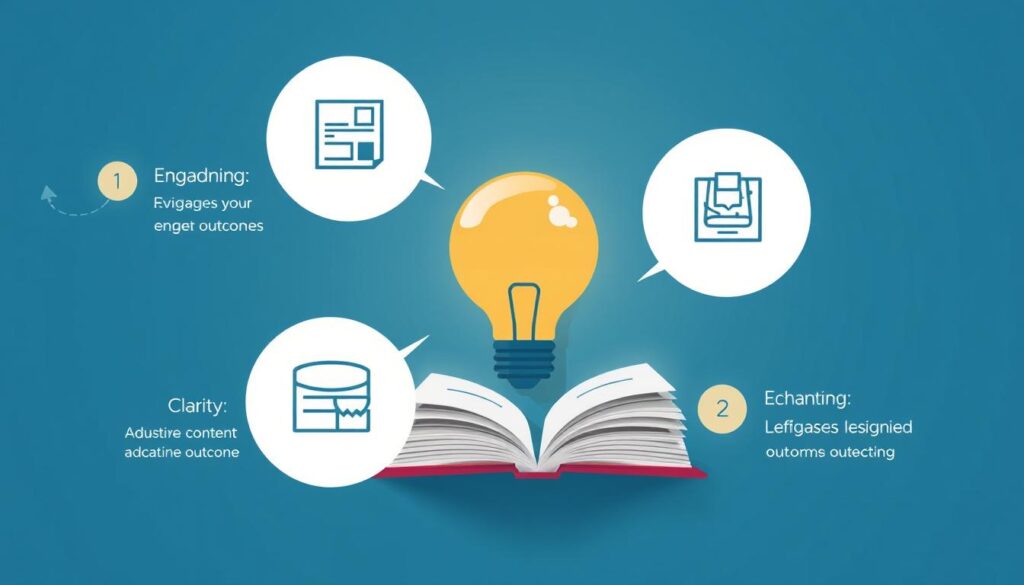Academic institutions are continually seeking innovative ways to engage their students and enhance the learning experience. One effective approach is through educational content writing services, which provide high-quality materials that inform, inspire, and captivate learners.
The importance of quality content cannot be overstated. It is the cornerstone of effective knowledge transfer, enabling institutions to convey complex concepts in an accessible manner. By leveraging professional writing services, academic institutions can elevate their teaching materials, improve student engagement, and ultimately enhance educational outcomes.
Key Takeaways
- Educational content writing services enhance the learning experience for students.
- Quality content is crucial for effective knowledge transfer in academic institutions.
- Professional writing services can improve teaching materials and student engagement.
- Academic institutions can benefit from specialised writing expertise that understands pedagogical principles.
- The digital transformation of education demands captivating and informative content.
Understanding Educational Content Writing in Academic Settings
In the realm of academia, educational content writing serves as a cornerstone for effective knowledge dissemination. Educational content writing aims to inform readers about scientific concepts without being dull. By leveraging various tools and techniques, writers can create engaging content that fosters a deeper understanding of complex topics among their audience.
Effective educational content is not just about conveying information; it’s about presenting it in a way that captivates the audience. This involves a deep understanding of both the subject matter and educational psychology to communicate complex concepts to diverse audiences effectively.
Defining Educational Content Writing for Academic Institutions
Educational content writing for academic institutions encompasses the creation of informative, structured, and pedagogically sound materials. These materials facilitate learning and knowledge transfer, requiring a blend of subject matter expertise and educational psychology. As Dr. Jane Smith, a renowned education expert, notes, “Educational content writing is not just about transferring knowledge, but about inspiring a love for learning.” By considering various learning styles, cultural contexts, and accessibility requirements, writers can create inclusive learning experiences.
The Evolution of Content in Educational Environments
The evolution of educational content has been dramatic, shifting from traditional textbooks and lecture notes to dynamic, multimedia-rich resources. Modern educational content writing balances academic rigour with accessibility, ensuring that materials are both intellectually stimulating and comprehensible for the intended audience. As educational institutions continue to embrace digital transformation, the demand for adaptable and engaging educational content will only continue to grow. According to a recent study, institutions that invest in high-quality educational content see a significant improvement in student engagement and outcomes. By staying abreast of these changes, educational content writers can continue to play a vital role in shaping the learning experiences of tomorrow.
The Strategic Importance of Quality Educational Content Writing
In the realm of academia, the strategic importance of quality educational content writing is becoming increasingly evident. As institutions strive to provide engaging and effective learning experiences, the role of well-crafted content cannot be overstated. Quality educational content writing serves as a powerful strategic asset, directly influencing student engagement, institutional reputation, and learning outcomes.

Enhancing Student Engagement Through Compelling Content
Well-crafted educational content creates meaningful connections with students, transforming passive information consumption into active learning experiences that inspire curiosity and critical thinking. By providing examples and practical applications, institutions can demonstrate the relevance of the material, thereby enhancing student engagement.
Building Institutional Authority and Reputation
Through compelling educational content, institutions can demonstrate their subject matter expertise and pedagogical innovation, establishing themselves as authorities in their academic fields. As
“When you can demonstrate you’re an authority on any topic through your content, you earn the trust of your readers.”
This trust is crucial for building a strong institutional reputation.
Supporting Learning Outcomes with Targeted Content
Educational content that resonates with students’ real-world concerns and aspirations significantly improves information retention and application, leading to better academic performance. By balancing theoretical foundations with practical applications, institutions can help students bridge the gap between abstract concepts and their relevance to professional contexts. This targeted content supports both formal learning objectives and informal knowledge acquisition, creating a more holistic educational experience.
By investing in quality educational content writing, institutions can create more cohesive learning journeys, where materials across different courses and departments share consistent quality and pedagogical approaches. The strategic deployment of educational content across various platforms and formats ensures that institutions can meet diverse learning preferences and accessibility needs.
Key Benefits of Professional Educational Content Writing Services

In today’s competitive academic landscape, the benefits of professional educational content writing services cannot be overstated. Academic institutions are increasingly recognising the value of high-quality educational content in enhancing student engagement and learning outcomes.
Time and Resource Optimisation for Academic Staff
Professional educational content writing services allow academic staff to optimise their time and resources more effectively. By outsourcing content creation, educators can focus on teaching and research while ensuring that their educational materials are of high quality.
Consistent Quality Across All Educational Materials
One of the significant benefits of employing professional writers is the consistency they bring to educational materials. They maintain high quality standards, creating a cohesive brand voice and educational approach that strengthens the institution’s identity.
Specialised Expertise in Subject Areas and Pedagogical Approaches
Educational content writing services bring specialised expertise in translating complex academic concepts into engaging and accessible materials. These professionals understand both the academic rigour required and the pedagogical techniques that make information accessible to diverse student populations.
The advantages of professional educational content writing services are multifaceted, including:
- Freeing up valuable faculty time to focus on teaching and research.
- Ensuring pedagogical consistency across departments.
- Bringing fresh perspectives to educational content.
- Providing scalability for institutions to rapidly develop or update materials.
- Improving student engagement, learning outcomes, and institutional reputation.
By leveraging these services, academic institutions can significantly enhance their educational offerings, ultimately leading to improved academic success.
Essential Types of Educational Content for Academic Institutions
Academic institutions require a diverse range of educational content to achieve their objectives. This content not only supports the core curriculum but also extends to various other areas that enhance the overall educational experience.
The diversity in content caters to different learning styles and preferences, ensuring that institutions can reach and engage their audience effectively. From traditional teaching materials to digital resources, the types of educational content are vast and varied.
Curriculum Materials and Course Content
Curriculum materials form the backbone of any academic institution, including syllabi, lecture notes, textbooks, and assessment materials. These resources directly support course objectives and are crucial for student learning.
Institutional Blogs and Knowledge Resources
Institutional blogs serve as a platform for faculty to share their insights and research, establishing the institution’s authority in specific academic domains. Additionally, knowledge resources such as white papers and research summaries provide valuable information for students and the wider community.
Student Recruitment and Engagement Materials
Student recruitment materials require a blend of informative and inspirational content to attract prospective students. These materials convey the institution’s educational philosophy and student experience, playing a crucial role in the recruitment process.
The following table summarises the key types of educational content and their purposes:
| Type of Content | Purpose | Examples |
|---|---|---|
| Curriculum Materials | Support course objectives | Syllabi, lecture notes, textbooks |
| Institutional Blogs | Share insights and research | Blog posts, research summaries |
| Student Recruitment Materials | Attract prospective students | Brochures, website content, social media posts |
By utilising a range of educational content types, academic institutions can enhance learning experiences, foster engagement, and convey their knowledge and expertise.
Best Practices in Educational Content Writing
Crafting educational content that resonates with academic audiences requires a deep understanding of their needs and preferences. Effective educational content writing is a multifaceted task that involves several key considerations to ensure that the material is engaging, informative, and accessible to the target audience.
Understanding Your Academic Audience
Understanding the academic audience is fundamental to creating effective educational content. This involves tailoring the content to the students’ prior knowledge, educational level, cultural backgrounds, and learning preferences. By doing so, writers can create content that resonates with their audience and enhances their learning experience. For instance, a study on instructional strategies can provide valuable insights into the needs of the academic audience.
Balancing Academic Rigour with Accessibility
Striking a balance between academic rigour and accessibility is crucial in educational content writing. The content should be intellectually stimulating without becoming unnecessarily complex or jargon-heavy. Clear, precise language forms the foundation of excellent educational content, with complex concepts broken down into manageable components without oversimplification. This balance is essential to maintaining the engagement of the readers.
Incorporating Multimedia and Interactive Elements
Incorporating multimedia elements, such as images, diagrams, videos, and interactive components, significantly enhances comprehension and engagement by addressing diverse learning styles. For example, using visual aids like diagrams and infographics can help to illustrate complex concepts, making them more accessible to a wider audience. The following table highlights the benefits of incorporating multimedia elements in educational content.
| Multimedia Element | Benefits |
|---|---|
| Images and Diagrams | Enhance visual understanding, illustrate complex concepts |
| Videos | Provide dynamic explanations, increase engagement |
| Interactive Components | Foster active learning, promote critical thinking |

By incorporating these best practices into educational content writing, writers can create high-quality content that enhances learning outcomes while maintaining academic integrity and student engagement.
Selecting the Right Educational Content Writing Services

Institutions of higher learning need to assess educational content writing services to ensure they produce high-quality content that meets academic standards. The process involves evaluating several key factors that determine the suitability of the service.
Evaluating Writer Qualifications and Subject Matter Expertise
The qualifications and expertise of writers are crucial in determining the quality of educational content. Look for services that employ writers with relevant academic credentials and subject matter expertise. This ensures that the content produced is not only well-researched but also accurate and relevant to the academic needs.
Assessing Service Flexibility and Customisation Options
A good educational content writing service should be flexible and able to customise its content to meet the specific needs of the institution. This includes adapting to the institution’s voice, style guidelines, and pedagogical approach. Customisation is key to ensuring that the content aligns with the institution’s overall academic strategy.
Reviewing Portfolio and Case Studies in Educational Writing
Reviewing the portfolio and case studies of potential educational content writing services provides valuable insights into their capabilities. Look for examples that demonstrate their ability to handle content similar to your requirements. This helps in assessing their expertise and the quality of content they can produce.
Other critical factors to consider include the service’s research capabilities, quality control processes, and communication protocols. Ensuring that the service has robust research capabilities and adheres to high-quality standards is vital. Transparent communication and project management systems also facilitate effective collaboration.
By carefully evaluating these factors, institutions can select an educational content writing service that meets their needs and produces high-quality, engaging content that supports their academic objectives.
Implementing Educational Content Strategy Across Academic Departments
Academic institutions can significantly benefit from implementing a unified educational content strategy across their departments. This approach ensures that educational content is consistent, high-quality, and aligned with the institution’s overall goals. A well-implemented strategy can enhance student engagement, improve learning outcomes, and foster a cohesive academic environment.
Creating a Unified Content Approach
Establishing a unified content approach begins with developing institutional content guidelines that maintain consistent quality standards while allowing for disciplinary variations. Cross-departmental content committees can facilitate knowledge sharing and resource optimisation across diverse academic units. This collaborative approach ensures that content creation workflows balance centralised oversight with departmental autonomy, promoting quality control without stifling individual expertise.
Measuring Content Effectiveness and Learning Impact
Measuring the effectiveness of educational content requires establishing clear metrics aligned with learning objectives. This includes tracking engagement analytics and assessment outcomes to demonstrate actual learning impact. Regular content audits help identify gaps, redundancies, and opportunities for improvement across the institution’s educational materials. By using data-driven insights, institutions can refine their content to better support student learning.
Continuous Improvement Through Feedback and Analytics
Feedback mechanisms should capture insights from multiple stakeholders, including students, faculty, and learning designers, to inform continuous content refinement. Analytics from learning management systems and digital platforms provide valuable data on how students interact with educational content, revealing which approaches most effectively support learning. By leveraging these insights, institutions can continuously improve their educational content and enhance the overall learning experience.
| Content Strategy Element | Description | Benefits |
|---|---|---|
| Unified Content Approach | Establishing institutional content guidelines | Consistent quality, disciplinary variations |
| Cross-Departmental Collaboration | Facilitating knowledge sharing and resource optimisation | Enhanced content quality, resource efficiency |
| Metrics for Content Effectiveness | Tracking engagement analytics and assessment outcomes | Data-driven insights, improved learning outcomes |
| Continuous Improvement | Capturing feedback from stakeholders and leveraging analytics | Refined content, enhanced learning experience |
The Future of Educational Content Writing for Academic Success
The landscape of educational content writing is evolving rapidly, driven by technological advancements and changing learner needs. As we move forward, it’s essential to understand that the future of educational content writing will be shaped by several key factors.
The integration of artificial intelligence and machine learning is transforming educational content creation, enabling more personalised learning experiences that adapt to individual student needs, preferences, and progress. This shift towards personalised learning is revolutionising the way educational content is developed and delivered.
Moreover, the growing emphasis on lifelong learning and professional development is expanding the scope of educational content beyond traditional degree programmes. This includes the development of microlearning resources, just-in-time learning materials, and modular content that supports continuous skill development. For more insights on the evolving landscape of educational content, you can refer to research studies such as the one published in the Journal of Web Librarianship.
To stay ahead, educational content writers and institutions must be willing to adapt and innovate. This includes embracing data-driven content optimisation, where analytics inform not just what content to create but how to structure and present it for maximum learning impact. Furthermore, the importance of accessibility and inclusivity in educational content development cannot be overstated, ensuring that materials serve diverse learner populations effectively.
The future of educational content writing is bright, with numerous opportunities for growth and innovation. By understanding the needs of their audience and leveraging the latest technologies and trends, educational content writers can create high-quality, engaging content that supports academic success.






